BioE Strikes Silver
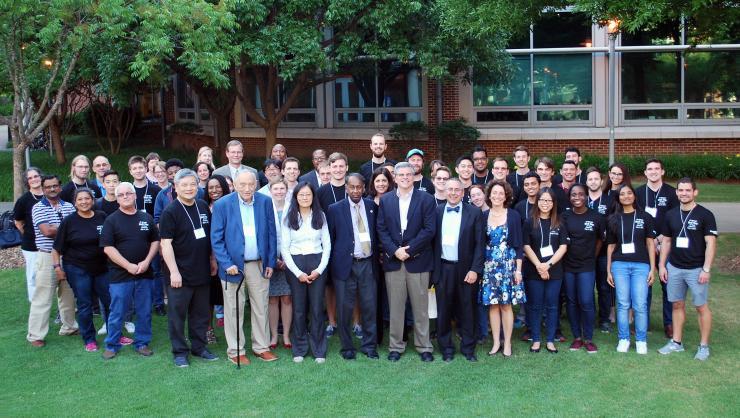
We are BioE. Graduate students, directors past and present, faculty, and staff gather in the quad.
British writer, futurist, explorer, and inventor Arthur C. Clarke said that new ideas go through three stages: “It can't be done. It probably can be done, but it's not worth doing. I knew it was a good idea all along!” Ajit Yoganathan, a member of the National Academy of Engineering, is familiar with all three stages.
As the architect of the Bioengineering Interdisciplinary Graduate Program – BioE – at the Georgia Institute of Technology, he can confidently claim a firm hold on the third one. He always knew it was a good idea, even if it took some colleagues a little longer to come around.
“Georgia Tech was losing students who were interested in bioengineering to other places, like Duke, Vanderbilt, Johns Hopkins,” says Yoganathan, Wallace H. Coulter Distinguished Faculty Chair and a Regents’ Professor in the Wallace H. Coulter Department of Biomedical Engineering (BME) at Georgia Tech and Emory. “That was the main factor driving creation of a bioengineering program here – we weren’t attracting the students we wanted.”
That doesn’t seem to be a problem anymore. Now one of the top-ranked programs of its kind in the nation, BioE observed its 25th anniversary, Friday, May 11, at the fifth annual BioE Day celebration. The first interdisciplinary graduate program at Georgia Tech, BioE remains one of the most popular, with 108 students from eight different home schools or departments currently enrolled.
“In many ways, BioE has been a trailblazer,” says Rob Butera, associate dean for research and innovation in Georgia Tech’s College of Engineering and, like Yoganathan, a researcher in the Petit Institute for Bioengineering and Bioscience, administrative headquarters for BioE.
“Now, of course, we have a number of interdisciplinary programs across campus, like Robotics and Machine Learning, among others. But because of BioE, the engineering schools are familiar with the concept,” adds Butera, who was the BioE program director, 2005-2008, following the departure of previous director, Tim Wick.
BioE Buy-In
Yoganathan, who served as BioE director from its inception (first as a Master’s program with the Ph.D. launching shortly thereafter) until 2004, says the program got an early buy-in from a number of schools.
“Mechanical engineering, electric engineering, aerospace engineering – they partnered with us early on, and the College of Computing came on board as well,” says Yoganathan, who was in the School of Chemical Engineering which, ironically, did not buy into the bioengineering program at first. This was the early 1990s. There weren’t that many bioengineering programs around. For Georgia Tech, this was a new idea.
“It was painful,” Yoganathan quips. “They were dubious at first, but they came along.”
Now called the School of Chemical and Biomolecular Engineering (ChBE), it’s one of eight departments that now feed the BioE program, along with aerospace engineering, biomedical engineering, civil and environmental engineering, electrical and computer engineering, materials science and engineering, mechanical engineering, and the College of Computing.
Students can enroll in BioE by selecting one of those home departments, which is where BioE’s 133 participating faculty come from.
“One of the keys to the program’s success is, all of the department chairs get it,” says Butera, a professor with joint appointments in the School of Electrical and Computer Engineering, and the Coulter Department of Biomedical Engineering.
The support of faculty is what drives the program, according to Butera. Without that engagement from home departments, there wouldn’t be a BioE program. Now, at 25 years old, BioE buy-in is a virtual slam-dunk. The participants, even from the more hesitant departments, saw the light long ago.
“The BioE program has been instrumental in allowing ChBE faculty to boldly pursue interdisciplinary research programs,” says David Sholl, ChBE chair. “The cross-pollination of expertise that has occurred in research groups that are able to include BioE students from a range of backgrounds is a wonderful example of Georgia Tech’s culture of valuing collaboration.”
One Staffer to Rule Them All
Throughout its history, the BioE Program has never had more than one full-time staffer, in addition to the faculty director and deputy director (currently Andrés García and Hang Lu, respectively). So far, two people have made lasting impressions as BioE academic advisors – Chris Ruffin, who passed away in 2013, and Laura Paige.
“Personally, I think Chris left an indelible mark on this program,” says Paige, BioE's current staff of one. “He was a leader and the face of this program. I’m not sure what my mark will be, but I am very aware that I had big shoes to fill and I try very hard to emulate him every day.”
Shortly after Ruffin died, BioE introduced the annual Christopher Ruffin Student Leadership Award, given to a student whose influence, ideals, and activities throughout his/her time in the BioE program leave a lasting impression, like Ruffin, who Butera describes as, “the voice of the program from an internal perspective.”
Most of the time, when a student had a question about the program, the stock answer was, “ask Chris.” Now, García’s stock answer is, “ask Laura.”
“Dedicated academic advisors like Laura and Chris make the program run smoothly and successfully,” says García, who has been director of the program since 2008, a period of time almost equal to Yoganathan’s. “They are the champions for the program. The huge success of BioE is a direct result of these wonderful advisors.”
While the official title has traditionally been “academic advisor,” Paige is more like an overall program administrator. If you ask BioE students about the different hats she wears, you’ll get a list that includes confidant, friend, enforcer-of-rules, events organizer, file auditor, liaison with home schools.
Grounded in Engineering
While staffers like Paige and Ruffin have been the administrative glue holding the disparate pieces of a graduate degree program together, the true success of the program, according to García, “is the lasting impact that our graduates have in academia, industry, government, and society as a whole. Our graduates are thought leaders and drivers of their professional and personal communities. We can talk about all the great metrics – numbers, GPA, pedigrees, papers – but this is what really counts and what I am most proud of.”
BioE stresses the role of the individual within the team – it provides a personalized curriculum, based on the student’s research interests, allowing for flexibility. As a discipline, BioE is a bit broader than its close cousin, BME.
“BioE is for students who are really interested in different disciplines – they want to be mechanical engineers or chemical engineers and learn how to apply that knowledge and those skills to solving biological problems,” says Wick, professor and senior associate dean in the School of Engineering at the University of Alabama-Birmingham. “BioE isn’t all about medical problems and human health. It has other focus areas also, such as agriculture.”
There is a great emphasis for BioE students on engineering fundamentals – they have to complete nine credit hours in engineering fundamentals.
“In my experience, nearly all bioengineering graduate programs are designed to build upon an undergraduate degree in the same field,” says Tom Bongiorno, an R&D project manager and stem cell scientist at California-based X-Therma, who earned his BioE Ph.D at Georgia Tech in 2016. “The BioE program at Georgia Tech is unique because it is designed to train extremely talented engineering students who have a focused interest in bioengineering but may lack formal training in biology.”
So, as a mechanical engineering undergraduate, Bongiorno found a perfect fit.
“My graduate lab certainly combined expertise in biology and engineering, but was strongest in engineering,” says Bongiorno, who happened to win the Ruffin Leadership Award. “The program prepared me for my current role as R&D project manager by endowing a full set of skills, including the abilities to understand both broad and deep scientific principles, to constructively criticize experimental plans, to optimize utilization of materials and researchers’ time and, perhaps most importantly, to communicate clearly with a diverse team.”
Celebrating 25 Years
Five years ago, BioE students and administrators came together to form BioE Day, an event designed to unify the grad program’s students and faculty, who come from all of those different home schools and are immersed in a wide range of research topics.
It’s a day that celebrates the end of another academic year. This time, they celebrated 25 years of BioE. There were the usual BioE Day events – a research poster session and rapid fire research presentations from the students, as well as recognition of the outstanding advisor and outstanding research paper, won this year by Mark Styczynski, associate professor in ChBE, and Monica McNerney, a student in his lab.
Styczynski couldn’t be present, so he did the next best thing. He sent a movie, a hilarious send-up of the Netflix series Stranger Things called Advisor Things.
“Now you know a little more about my advisor,” McNerney said, struggling to keep a straight face.
This year, there were two keynote speakers: Georgia Tech graduate Abigail Wojtowicz, formerly of García’s lab, spoke about career development, and told the story of her path from a Ph.D. to a career in industry. Later in the day, BME Associate Professor Manu Platt delivered a stirring presentation on the need to embrace diversity, to continue fostering an inclusive graduate program.
“Diversity always pays off – it isn’t charity,” Platt told a packed room in the Marcus Nanotechnology Building, including past BioE directors Yoganathan and Butera, among others.
Then, before adjourning to dinner across Atlantic Drive at the Petit Institute, García announced the winners of the annual BioE Day awards: Brett Klosterhoff won the rapid fire competition. Josh Hooks won for his research poster, and got a big hand when he was announced as the Christopher Ruffin Student Leadership Award winner. It’s become one of the most cherished prizes for any Georgia Tech BioE student. The other, of course, is a diploma.
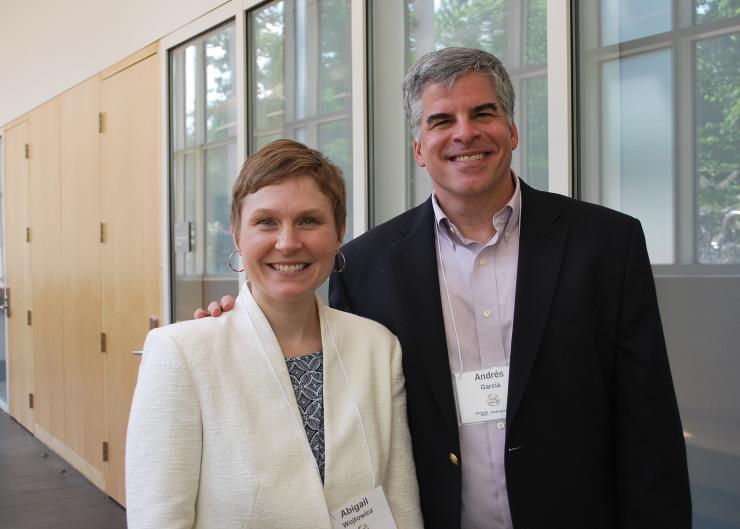
Andrés García greets his former student, Abigail Wojtowicz, a keynote speaker at BioE Day.
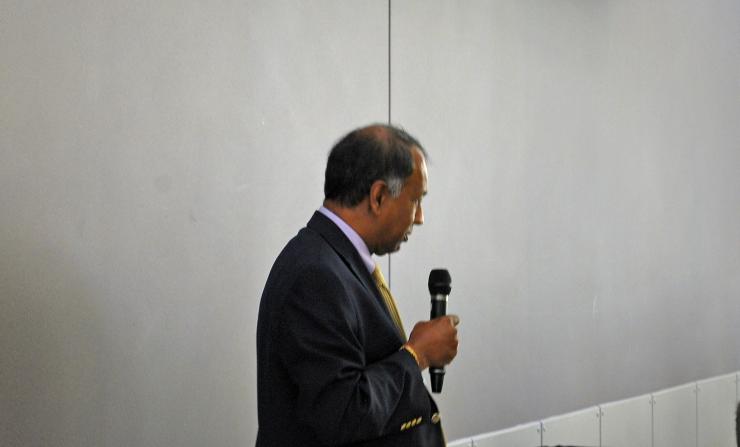
Ajit Yoganathan, who launched the BioE program 25 years ago, shares his thoughts with a packed Petit Institute atrium.
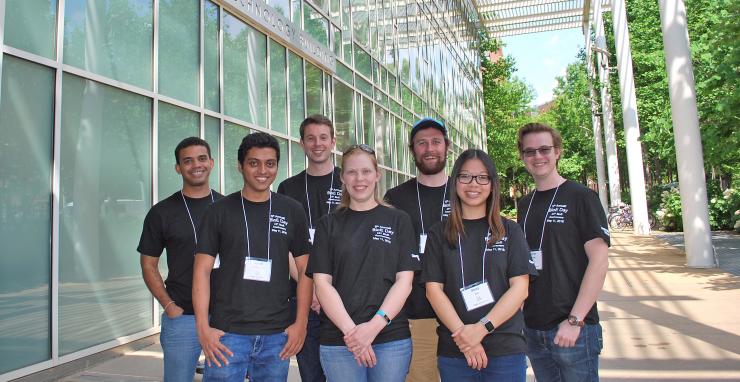
This group of BioE grad students provided rapid fire research presentations.
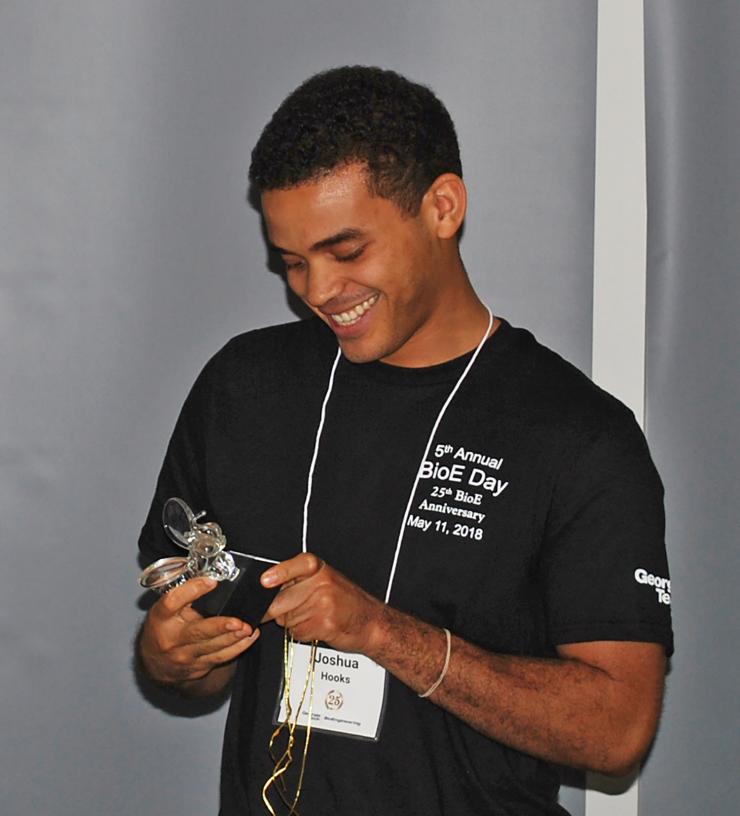
Josh Hooks won the Christopher Ruffin Student Leadership Award.

Happy silver anniversary, BioE.
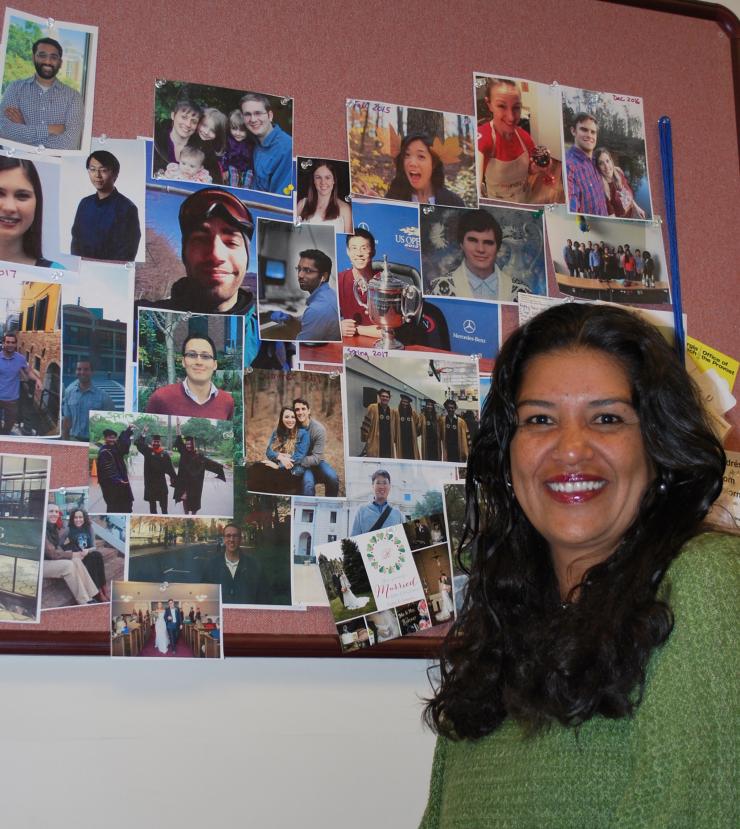
Laura Paige wears many hats as academic advisor for BioE. She's been the go-to person for many students over the years.
